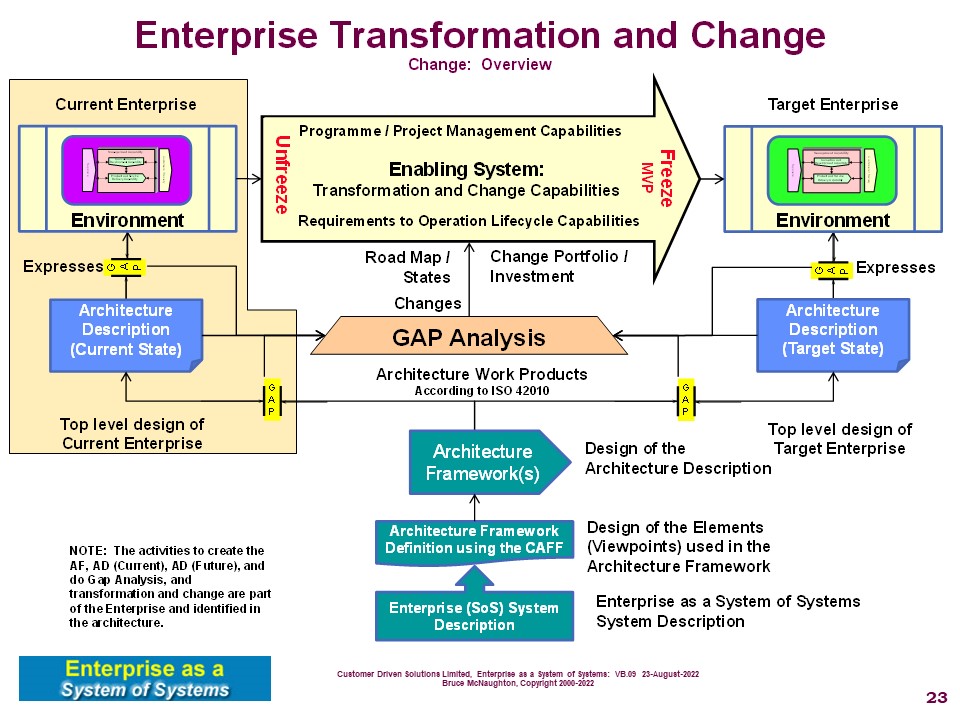Understanding the current state of the enterprise is critical to transformation and change of the enterprise.

There are many approaches to describing the way the current organization works, or assessment of the current state. If these approaches have been carried out, the current state should be visible and in some cases understood.
Though modeling of the current state has some value, the main aspects of the assessment should be looking at whats working and what's not working and whether continued use of this will achieve the enterprise objectives. The architecture description may be good and the implementation of the architecture description may be poor.
Once the key areas of the current state are understood along with the costs of continuing as realized, the need for change will be visible. This step identifies the need and some of the operational changes that are required.
Eventually if the architectural approach to transformation and change is used, the target architecture description will become the current architecture description and reflect the expected position for the enterprise.
In some organizations, architecture descriptions that describe how the current realized enterprise are available. These should be used to help assess Gap 2 below.
Audits or assessments of the architectural approach, (eg using ISO 42010 or other assessment approaches such as ISO 9001 or the CMMI). These will examine the practices that shape the structure of the enterprise.
Gaps are identified between the Architecture Description Framework and the Architecture Description. These may be due to the following.
- An architecture description was not produced and does not provide any reference point for the current state assessment.
- Due to the time and budget available, some of the areas of the Architecture Description Framework were not implemented. This supports an incremental approach to transforming and changing the enterprise.
- A view of the architecture description may not have been created correctly using the associated viewpoint. This may lead to incorrect implementation and a resulting problem within the realized enterprise. This may be due to a problem with the Architecture Description Framework or with the way the view instructions were carried out. Corrective action will be required in both cases.
- Include a decision tree for the various possibilities related to this gap.
Each step in the transformation process will be testing the views in the architecture description. The results of this usage ensures traceability and correct understanding of the architecture views.
There are many assessment capabilities that assess the current state of an enterprise:
- ISO 9001, the CMMI, the EFQM assessments, the Baldridge assessment. These can be used for all of or part of an enterprise and provide a good understanding of the current practices and how well they have been implemented.
People focused assessments of the enterprise.
- The PeopleCMM, Investors in People, and some Cultural Assessments
All of the above provide feedback and input to a current state assessment of the enterprise.
The following activities would also be considered:
- Identify and consolidate the current state problems and issues that need to be addressed.
- Identify the 'no change' position ... projected into the future
- Identify the costs and performance implications of these problems (in business terms).
As the enterprise develops, an architecture description may or may not exist for the enterprise.
If the current state architecture description does not exist, any work to assess the current state should be added back into the architecture description. This ensures that the current state architecture description is established with current information from the assessments.
The types of gaps that arise from Gap 02 are:
- Cultural issues
- People in positions with the incorrect level of skills, knowledge, experience, attitudes, behavior and beliefs.
- Capabilities not performing as expected
- Teams not performing as expected.
- Incomplete implementation of the architecture description.
- Mis-interpretation of the architecture description through to realization.
- Missing capabilities
- Organizational Structure improvements.
- Plan (schedule or capacity or funding) revisions.
- Enabling System: Capabilities necessary for the enabling system (project management or life cycles)
- Enabling System: Capabilities for business change and deployment of solutions.
- Enabling System: Current state change capabilities.
The mix of problems identified through Gap 02 require a number of different approaches to addressing the problems. Not all of the options available are architectural solutions.
All of these problems require support through the appropriate life cycles to improve the implementation in the current organization.
Some of the gaps identified above may be closed using current state change capabilities. These can generally handle the following types of changes:
- Increase the size of the team.
- Increase the capacity of critical skills, knowledge or experience
- Change the individuals in positions that need a different set of skills, knowledge, experience attitudes and behaviours.
These changes can be carried out using:
- Standard management practices
- Lean Six Sigma
- Process improvement capabilities
- Information system implementation and support
These changes will be tracked to completion through normal reporting channels.
To close this step, a summary and recommended actions document is created to capture the findings of the current state within the enterprise.
In addition, a simple architecture description may be created or if one exists, updated to reflect the current realization relative to the current architecture description.
Types of conclusions:
- Architecture Descriptions is needed
- Architecture Description is fine and the realization is poor
- Architecture Description needs to be updated and the enterprise is to be transformed.